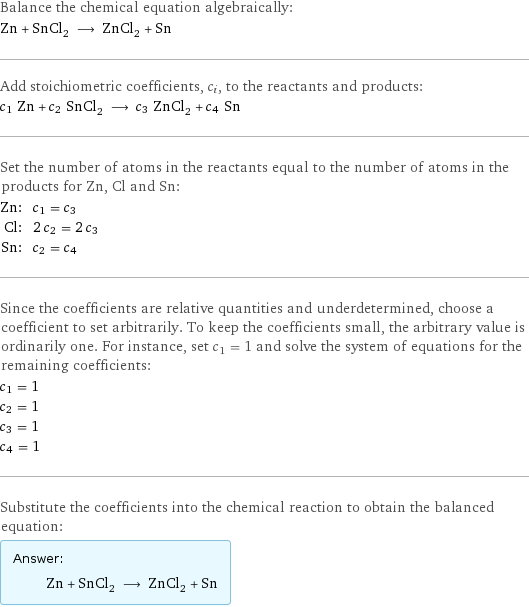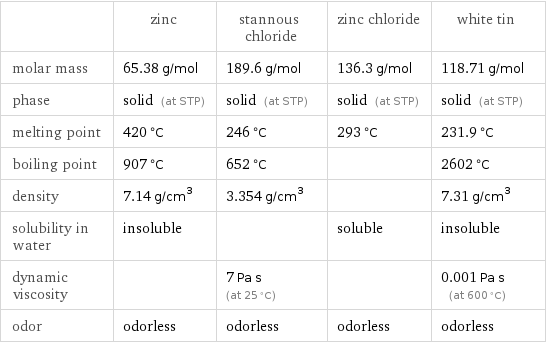Input interpretation

Zn zinc + SnCl_2 stannous chloride ⟶ ZnCl_2 zinc chloride + Sn white tin
Balanced equation

Balance the chemical equation algebraically: Zn + SnCl_2 ⟶ ZnCl_2 + Sn Add stoichiometric coefficients, c_i, to the reactants and products: c_1 Zn + c_2 SnCl_2 ⟶ c_3 ZnCl_2 + c_4 Sn Set the number of atoms in the reactants equal to the number of atoms in the products for Zn, Cl and Sn: Zn: | c_1 = c_3 Cl: | 2 c_2 = 2 c_3 Sn: | c_2 = c_4 Since the coefficients are relative quantities and underdetermined, choose a coefficient to set arbitrarily. To keep the coefficients small, the arbitrary value is ordinarily one. For instance, set c_1 = 1 and solve the system of equations for the remaining coefficients: c_1 = 1 c_2 = 1 c_3 = 1 c_4 = 1 Substitute the coefficients into the chemical reaction to obtain the balanced equation: Answer: | | Zn + SnCl_2 ⟶ ZnCl_2 + Sn
Structures

+ ⟶ +
Names

zinc + stannous chloride ⟶ zinc chloride + white tin
Equilibrium constant
![Construct the equilibrium constant, K, expression for: Zn + SnCl_2 ⟶ ZnCl_2 + Sn Plan: • Balance the chemical equation. • Determine the stoichiometric numbers. • Assemble the activity expression for each chemical species. • Use the activity expressions to build the equilibrium constant expression. Write the balanced chemical equation: Zn + SnCl_2 ⟶ ZnCl_2 + Sn Assign stoichiometric numbers, ν_i, using the stoichiometric coefficients, c_i, from the balanced chemical equation in the following manner: ν_i = -c_i for reactants and ν_i = c_i for products: chemical species | c_i | ν_i Zn | 1 | -1 SnCl_2 | 1 | -1 ZnCl_2 | 1 | 1 Sn | 1 | 1 Assemble the activity expressions accounting for the state of matter and ν_i: chemical species | c_i | ν_i | activity expression Zn | 1 | -1 | ([Zn])^(-1) SnCl_2 | 1 | -1 | ([SnCl2])^(-1) ZnCl_2 | 1 | 1 | [ZnCl2] Sn | 1 | 1 | [Sn] The equilibrium constant symbol in the concentration basis is: K_c Mulitply the activity expressions to arrive at the K_c expression: Answer: | | K_c = ([Zn])^(-1) ([SnCl2])^(-1) [ZnCl2] [Sn] = ([ZnCl2] [Sn])/([Zn] [SnCl2])](../image_source/9bfc6b8c45a1bdcd1f3782516152c938.png)
Construct the equilibrium constant, K, expression for: Zn + SnCl_2 ⟶ ZnCl_2 + Sn Plan: • Balance the chemical equation. • Determine the stoichiometric numbers. • Assemble the activity expression for each chemical species. • Use the activity expressions to build the equilibrium constant expression. Write the balanced chemical equation: Zn + SnCl_2 ⟶ ZnCl_2 + Sn Assign stoichiometric numbers, ν_i, using the stoichiometric coefficients, c_i, from the balanced chemical equation in the following manner: ν_i = -c_i for reactants and ν_i = c_i for products: chemical species | c_i | ν_i Zn | 1 | -1 SnCl_2 | 1 | -1 ZnCl_2 | 1 | 1 Sn | 1 | 1 Assemble the activity expressions accounting for the state of matter and ν_i: chemical species | c_i | ν_i | activity expression Zn | 1 | -1 | ([Zn])^(-1) SnCl_2 | 1 | -1 | ([SnCl2])^(-1) ZnCl_2 | 1 | 1 | [ZnCl2] Sn | 1 | 1 | [Sn] The equilibrium constant symbol in the concentration basis is: K_c Mulitply the activity expressions to arrive at the K_c expression: Answer: | | K_c = ([Zn])^(-1) ([SnCl2])^(-1) [ZnCl2] [Sn] = ([ZnCl2] [Sn])/([Zn] [SnCl2])
Rate of reaction
![Construct the rate of reaction expression for: Zn + SnCl_2 ⟶ ZnCl_2 + Sn Plan: • Balance the chemical equation. • Determine the stoichiometric numbers. • Assemble the rate term for each chemical species. • Write the rate of reaction expression. Write the balanced chemical equation: Zn + SnCl_2 ⟶ ZnCl_2 + Sn Assign stoichiometric numbers, ν_i, using the stoichiometric coefficients, c_i, from the balanced chemical equation in the following manner: ν_i = -c_i for reactants and ν_i = c_i for products: chemical species | c_i | ν_i Zn | 1 | -1 SnCl_2 | 1 | -1 ZnCl_2 | 1 | 1 Sn | 1 | 1 The rate term for each chemical species, B_i, is 1/ν_i(Δ[B_i])/(Δt) where [B_i] is the amount concentration and t is time: chemical species | c_i | ν_i | rate term Zn | 1 | -1 | -(Δ[Zn])/(Δt) SnCl_2 | 1 | -1 | -(Δ[SnCl2])/(Δt) ZnCl_2 | 1 | 1 | (Δ[ZnCl2])/(Δt) Sn | 1 | 1 | (Δ[Sn])/(Δt) (for infinitesimal rate of change, replace Δ with d) Set the rate terms equal to each other to arrive at the rate expression: Answer: | | rate = -(Δ[Zn])/(Δt) = -(Δ[SnCl2])/(Δt) = (Δ[ZnCl2])/(Δt) = (Δ[Sn])/(Δt) (assuming constant volume and no accumulation of intermediates or side products)](../image_source/9fcbe241288995683dc0e4d297ee77a8.png)
Construct the rate of reaction expression for: Zn + SnCl_2 ⟶ ZnCl_2 + Sn Plan: • Balance the chemical equation. • Determine the stoichiometric numbers. • Assemble the rate term for each chemical species. • Write the rate of reaction expression. Write the balanced chemical equation: Zn + SnCl_2 ⟶ ZnCl_2 + Sn Assign stoichiometric numbers, ν_i, using the stoichiometric coefficients, c_i, from the balanced chemical equation in the following manner: ν_i = -c_i for reactants and ν_i = c_i for products: chemical species | c_i | ν_i Zn | 1 | -1 SnCl_2 | 1 | -1 ZnCl_2 | 1 | 1 Sn | 1 | 1 The rate term for each chemical species, B_i, is 1/ν_i(Δ[B_i])/(Δt) where [B_i] is the amount concentration and t is time: chemical species | c_i | ν_i | rate term Zn | 1 | -1 | -(Δ[Zn])/(Δt) SnCl_2 | 1 | -1 | -(Δ[SnCl2])/(Δt) ZnCl_2 | 1 | 1 | (Δ[ZnCl2])/(Δt) Sn | 1 | 1 | (Δ[Sn])/(Δt) (for infinitesimal rate of change, replace Δ with d) Set the rate terms equal to each other to arrive at the rate expression: Answer: | | rate = -(Δ[Zn])/(Δt) = -(Δ[SnCl2])/(Δt) = (Δ[ZnCl2])/(Δt) = (Δ[Sn])/(Δt) (assuming constant volume and no accumulation of intermediates or side products)
Chemical names and formulas

| zinc | stannous chloride | zinc chloride | white tin formula | Zn | SnCl_2 | ZnCl_2 | Sn Hill formula | Zn | Cl_2Sn | Cl_2Zn | Sn name | zinc | stannous chloride | zinc chloride | white tin IUPAC name | zinc | dichlorotin | zinc dichloride | tin
Substance properties

| zinc | stannous chloride | zinc chloride | white tin molar mass | 65.38 g/mol | 189.6 g/mol | 136.3 g/mol | 118.71 g/mol phase | solid (at STP) | solid (at STP) | solid (at STP) | solid (at STP) melting point | 420 °C | 246 °C | 293 °C | 231.9 °C boiling point | 907 °C | 652 °C | | 2602 °C density | 7.14 g/cm^3 | 3.354 g/cm^3 | | 7.31 g/cm^3 solubility in water | insoluble | | soluble | insoluble dynamic viscosity | | 7 Pa s (at 25 °C) | | 0.001 Pa s (at 600 °C) odor | odorless | odorless | odorless | odorless
Units
